The Getty Sheds New Light on the Early History of Photography

Gustave Le Gray, Mollien Pavilion, the Louvre, 1859. Albumen silver print. Courtesy The J. Paul Getty Museum, Los Angeles
The Getty Museum’s new exhibition Real/Ideal: Photography in France, 1847–1860 delves into the early history of photography at a moment when French photographers were making enormous strides in developing the medium’s technical and aesthetic possibilities. Drawn largely from the Getty’s significant collection of nineteenth-century photography—including an important recent acquisition of thirty-nine works of French and British photographs—Real/Ideal presents the work of four photographers: Édouard Baldus, Gustave Le Gray, Henri Le Secq, and Charles Nègre. In advance of the opening, Nicholas Robbins spoke with Karen Hellman, Assistant Curator in the Getty’s Department of Photographs and the organizer of Real/Ideal, about the genesis and themes of the show.
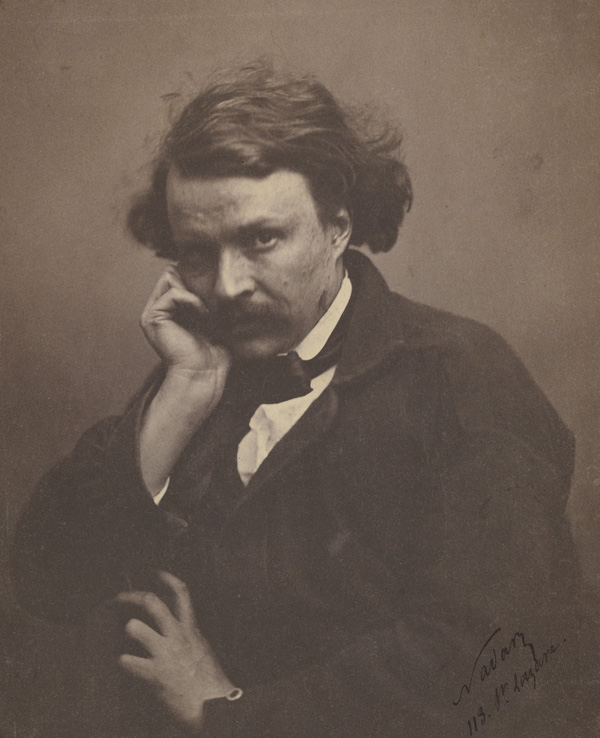
Nadar (Gaspard Félix Tournachon), Self-Portrait, ca. 1855. Salted paper print. Courtesy The J. Paul Getty Museum, Los Angeles
Nicholas Robbins: How did the idea for Real/Ideal come about?
Karen Hellman: I’ve always been interested in the idea of realism, in art and in literature. The era of realism in the mid-nineteenth century was an extremely important period in photography, following the “invention era” (1830s to the mid-1840s), but preceding the moment when more systematic and commercial means (paper, format, negatives, cameras, and lenses) became common in the 1860s. In her catalogue essay, Sylvie Aubenas calls the moment an “interregnum.” I’m also interested in questions about photography as opposed to other art forms. In mid-nineteenth-century France, photography was developed and debated as an art form at the same time that the realist writers and painters, such as Balzac and Jean-François Millet, were creating novels and canvases dealing with contemporary protagonists, whether Parisians or farmworkers. Such approaches to representing life seemed like the right framework for this exhibition.
Robbins: Given the Getty’s rich holdings of work from this period, I imagine it was difficult to edit the selection of photographs for the show. How did you choose to organize the show—thematically, or by maker?
Hellman: It was challenging to edit the selection for the show because it couldn’t be a comprehensive survey of the period—there were many photographers working at this time who were exploring the medium before there were established practices. To select four photographers that the Getty holds in depth was a way to compare four different approaches to the same subjects. For example, Baldus and Nègre both photographed the Cloister at St. Trophime in Arles, but while Baldus experimented with using multiple negatives to gain a wider perspective of the medieval corridor, Nègre photographed a vertical slice of the cloister with a greater interest in the dynamics of alternation between light and shadow than in a comprehensive view.
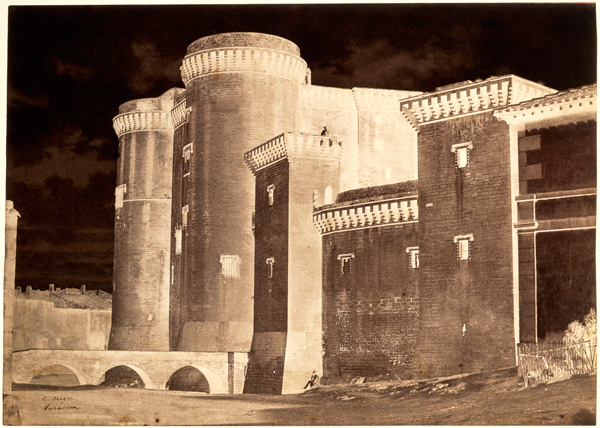
Charles Nègre, Tarascon, 1852. Waxed paper negative. Courtesy The J. Paul Getty Museum, Los Angeles
Robbins: I’m excited to see that the exhibition includes a number of paper negatives, which were part of a recent acquisition by the Getty. What drove the museum to bring these negatives into the collection? And how does seeing the “positives” with the “negatives” change our experience of the images or our understanding of their technical innovations?
Hellman: Negatives have, particularly in more recent years, been given short shrift in photography studies even though they were some of the earliest forms of photography. It’s harder to look at and read a negative image—we have to work a little harder to understand it—rather than the relatively straightforward ways we read the positive image. But I think that’s a good thing. The negative is an essential part of the history of photography and it is important for museum collections, particularly a collection like that of the Getty Museum, which holds a great deal of early photography, to recognize this and to preserve early paper negatives.
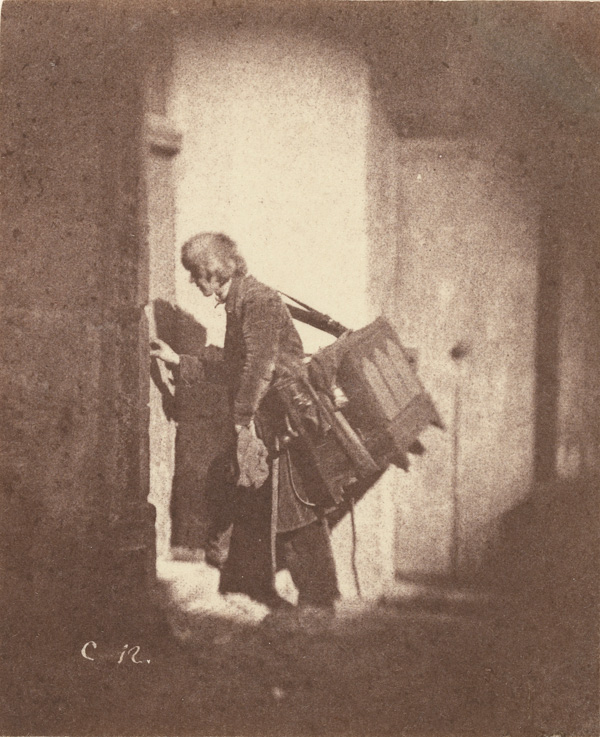
Charles Nègre, Organ Grinder at 21, quai Bourbon, Ile Saint-Louis, Paris, ca. 1853. Salted paper print from a paper negative. Courtesy The J. Paul Getty Museum, Los Angeles
Robbins: The exhibition has a compelling historical frame—looking at the paper negative’s invention and popularity between 1847 and 1860, a period of great social and political change in France. How do political and social histories, whether the revolutions of 1848 or the policies of Napoléon III, enter into the photographs? Or into the projects these photographers undertook?
Hellman: Nothing historically, artistically, or photographically works within perfect frames, of course, but this period in photography and in France was one that seemed to provide a good structure for a general audience to consider photography in a particular way. Political and social histories do and do not enter into these photographs. The photographic processes were too slow to create the photo-journalistic documents of, for example, the revolutions of 1848 in the way we are used to today. What I find interesting is that photographers of the 1850s explored many of the same social subjects as realist painters and writers—mostly because they had to. Those were the people around them or on the street, in quiet city squares, or in farm scenes. They also photographed the great historical architectural monuments of France for patrimony and were commissioned, under both the Republic and the government of Napoléon III, to photograph honorific views of France and French architecture. So they were capturing both the real and the ideal and in both endeavors they had great challenges to overcome.
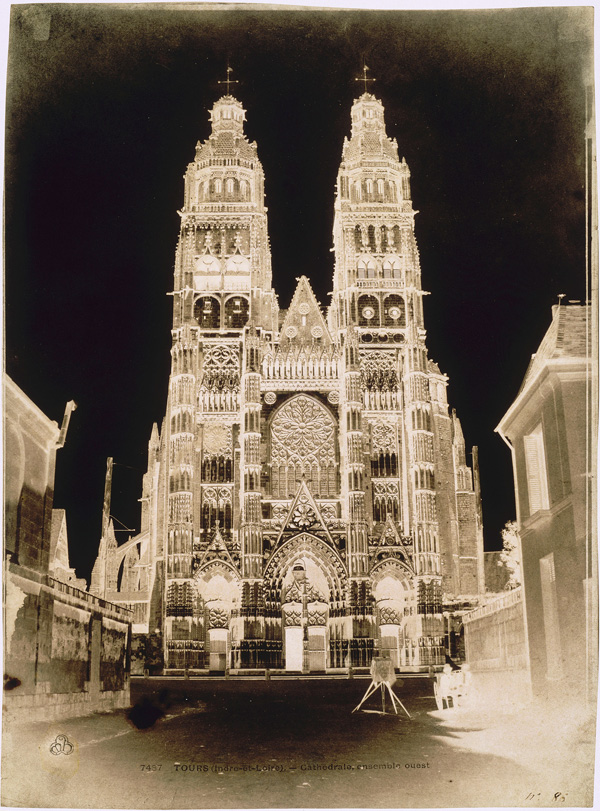
Gustave Le Gray and Auguste Mestral, West Facade of the Cathedral of Saint-Gatien, Tours, 1851. Waxed paper negative. © RMN-Grand Palais/Art Resource, NY
Robbins: As the title suggests, the exhibition addresses the realism of photography as well as the idealism of art and of creative innovation. How do you think these photographs shaped an understanding of what realism is—especially in light of the contemporaneous debates about realism in visual culture—with the work of Courbet and others?
Hellman: Real/Ideal seemed to epitomize the basic binary that photography inevitably complicates and never resolves, being tied to the real—more so than other art forms—but also a medium that can be innovative and experimental just like other art forms.
Robbins: This show overlaps, briefly, with the Getty’s groundbreaking show on the French painter Théodore Rousseau (1812–1867). What interactions between French landscape painting and photography do you see developing in the works in the exhibition?
Hellman: There have been some wonderful exhibitions about the interactions between French landscape painting and photography, as that is the subject and the literal “terrain” that both painters and photographs actually inhabited in the 1850s (most famously in the forest of Fontainebleau outside of Paris). In this exhibition I purposefully steered away from the forest in favor of the built environment. What I find interesting about photography from this period is that it can’t help capturing certain aspects that painters would perhaps leave out or control in some way: a ragged path and variably focused blend of trees and rocks; a clothes line outside a building; merchants on the street; scaffolding and nineteenth-century signage outside an eleventh- or twelfth-century cathedral; as well as the unintended blur of a passerby or horse-drawn carriage.

Gustave Le Gray, Seascape with a Ship Leaving Port, 1857. Albumen silver print. Courtesy The J. Paul Getty Museum, Los Angeles
Robbins: The chemical and technological experimentation of early photography often present a corollary scientific challenge to current conservation and museum science, and the Getty is at the forefront of this work.
Hellman: Yes, and technical research played a big role in selecting works for Real/Ideal and actually inspired a larger project on paper negatives that will extend beyond the exhibition. In collaboration with museum colleagues in Paris, the Getty Museum and the Getty Conservation Institute will continue to collaborate over the next year on technical analysis of French calotypes, for which the negatives at the Getty are being analyzed along with a large selection of negatives in Paris institutions, including the holdings of French calotypes at the Bibliothèque nationale de France.
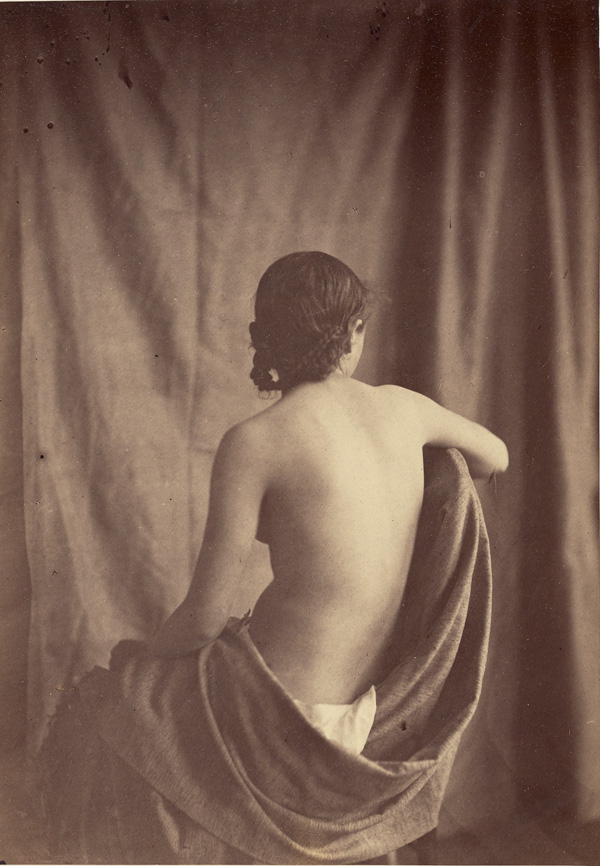
Jean-Louis-Marie-Eugène Durieu and possibly with Eugène Delacroix, Draped Model, ca. 1854. Albumen silver print. Courtesy The J. Paul Getty Museum, Los Angeles
Robbins: In 1850, Le Gray predicted, “the entire future of photography is on paper.” How does the work of these photographers connect to the current status of photographic technologies, when, at the same time, we have advancements in digital printing as well as photographs completely dematerializing, existing only as numeric codes and pixels? Do you see ways in which the same issues are being posed in contemporary photography and art history—that is, the nature of photographic realism versus the presentation of ideal or technologically-advanced or altered images?
Hellman: Many of the same issues that photographers were tackling in the early decades continue to be issues for photographers and artists today. I’m thinking contemporary artists who refer to themselves as artists using photography, rather than as photographers, for example Cindy Sherman or Andreas Gursky. Comparing the work of these photographers from the 1850s (and the photographic technologies developed then) to digital and virtual today, the technology may be different but the debates are fairly consistent. Photography has always contended with its tie to the “real” and today, as it was then in the 1850s, those issues or contentions continue to inspire some of the most thoughtful and innovative works of contemporary art and photography.
Nicholas Robbins is a doctoral candidate in the History of Art at Yale University.
Real/Ideal: Photography in France, 1847–1860 is on view through November 27, 2016 at the J. Paul Getty Museum in Los Angeles.























